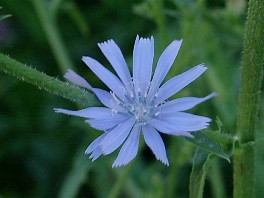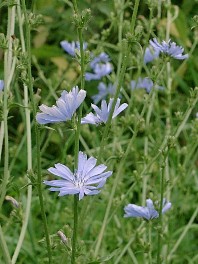 The blue flourishing Chicory grows beside roads and paths.
Most people don't even see this plant growing there, because it is quite flimsy.
The blue flourishing Chicory grows beside roads and paths.
Most people don't even see this plant growing there, because it is quite flimsy.
In ancient times and in the middle ages the Chicory was famous as a magical herb. It was very valuable because of this.
Today the Chicory is used to strengthen the digestion and you can make a coffee substitute from the roots.
Chicory is one of the Bach flower essences also.
Medicinal Uses
- Stimulating
- Gall stones
- Digestive weakness
- Constipation
- Liver tumescence
- Liver problems
- Portal vein stowage
- Galls strengthening
- Splenetic tumescence
- Hemorrhoids
- Varicose veins
- Blood cleaning
- Metabolism strengthening
- Diabetes
- Uterine strengthening
- Headaches
- Ulcers
- Hair loss
- Skin impurities
- Coffee substitute
Information
| Other Names: | Chickory, Succory, Witloof |
| Used Parts: | Root, Leaves, Flowers |
| Substances: | Anthocyanin, Betain, Bitter essence, Cichoriin, Coumarin, Essential oil, Intybin, Inulin, Kaempferol, Resin, Salicylate, Tannic essence, Tannic acid, Taraxasterol, Umbelliferone, Vitamins |
| Time to collect: | Root: March until April and October and November, Herb: June until Sepember, Flowers: July until September |
Methods
 The root of the Chicory can be used as a tea or tincture against problems of the digestive system.
The root of the Chicory can be used as a tea or tincture against problems of the digestive system.
The leaves can help against skin problems.
As the root has a lot of inulin, it can be eaten by people suffering from diabetes.
Coffee substitute
A coffe made from the Chicory root is tasty and helps the digestion. It was often used in times, when coffee was difficult to be bought. To prepare Chicory-coffee:- cut the root in small pieces and dry them
- roast the dry roots
- make a powder of the roasted roots
- cook this powder like normal coffee. The taste of the drink reminds on coffee.
Plant description
 Chicory likes to grow beside raods and ways.
You can also find it at the edge of fields and near railways.
Chicory likes to grow beside raods and ways.
You can also find it at the edge of fields and near railways.
In springtime the leaves grow at the ground. These leaves remind one of the leaves of Dandelion, but they are bigger.
In the summer a stalk is growing up to one meter with several branches. On the stalk there grow small leaves.
Where the stalk branches out the blue flowers blossom. You can find flowers until autumn comes.
